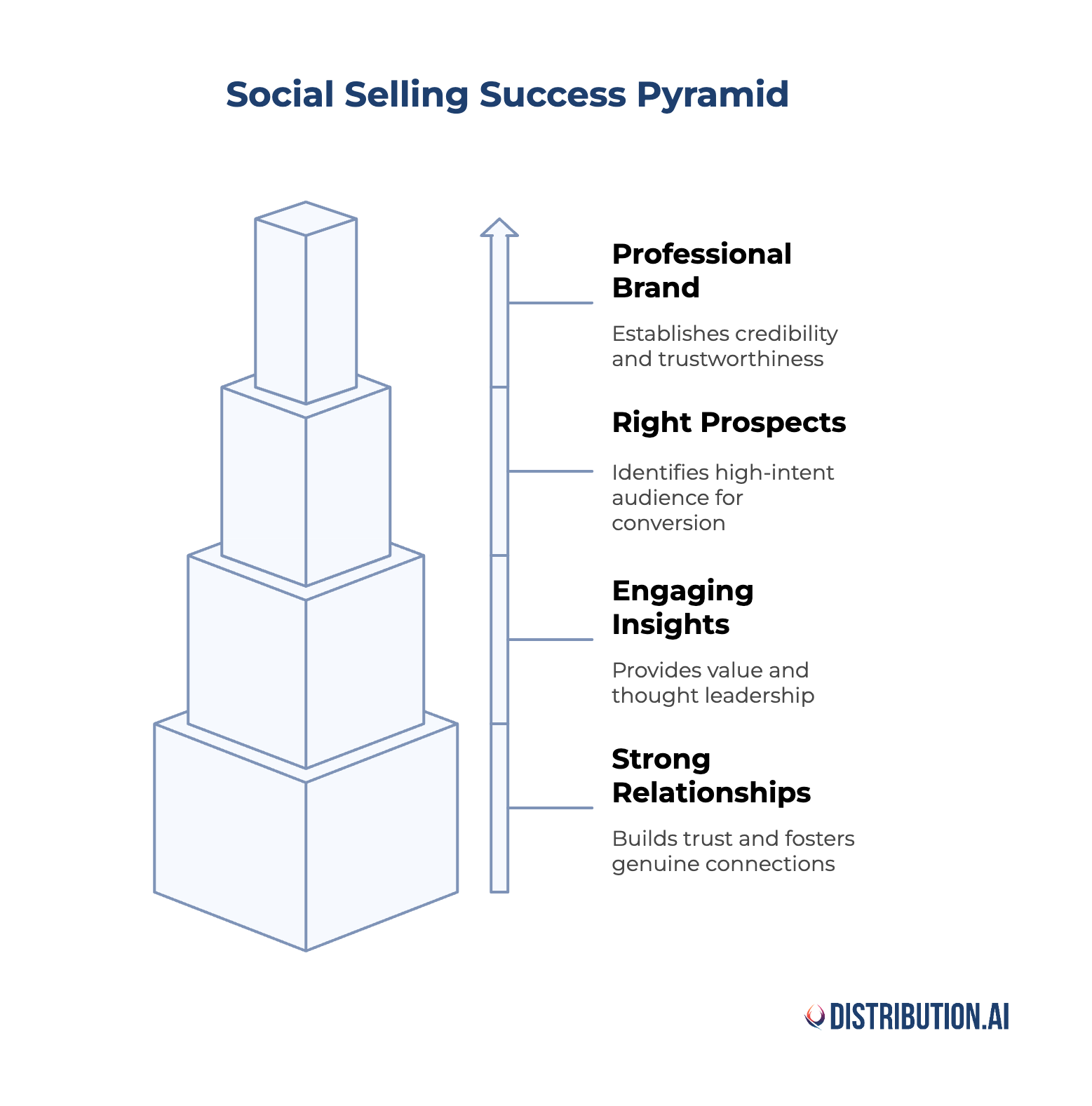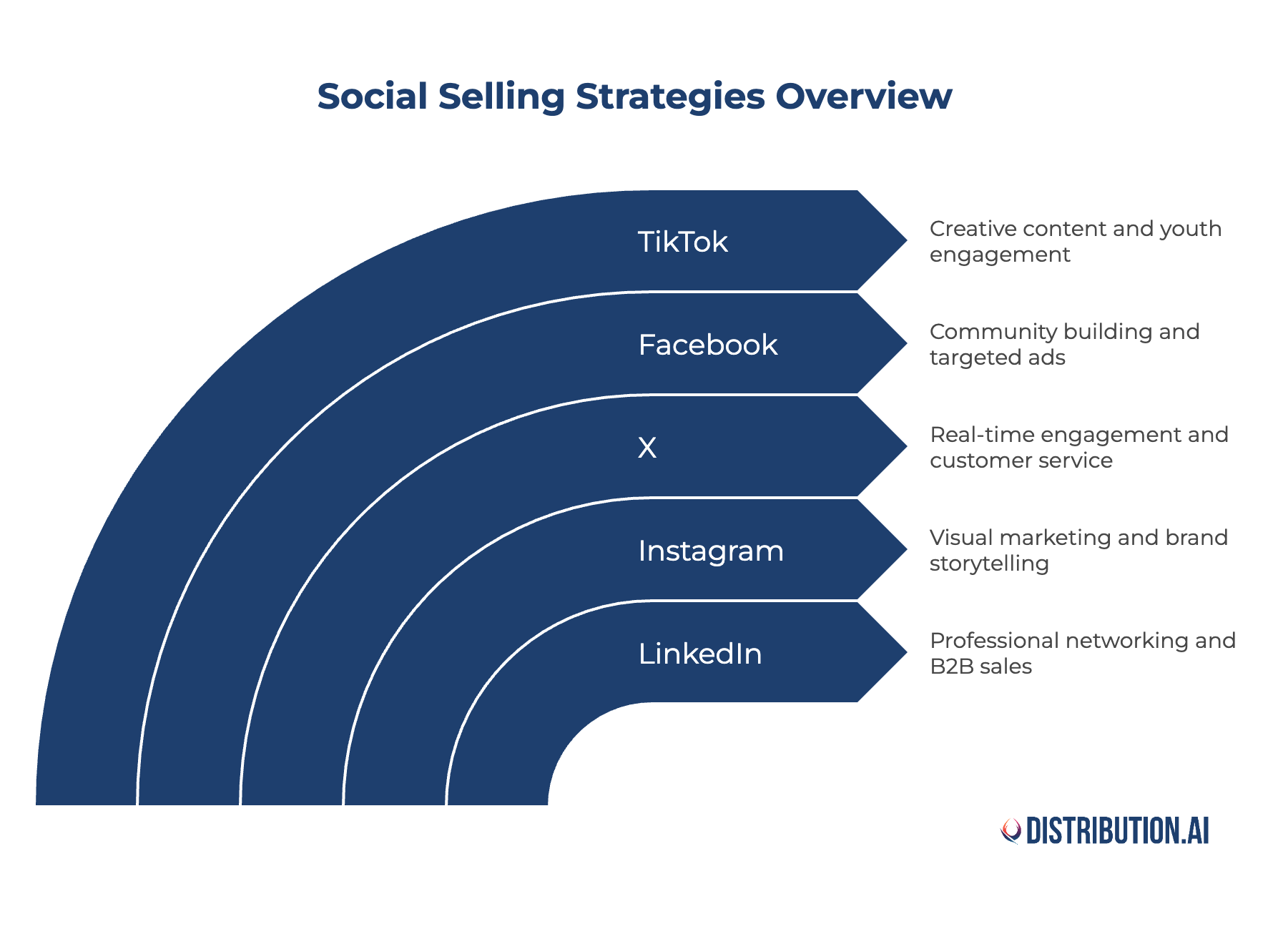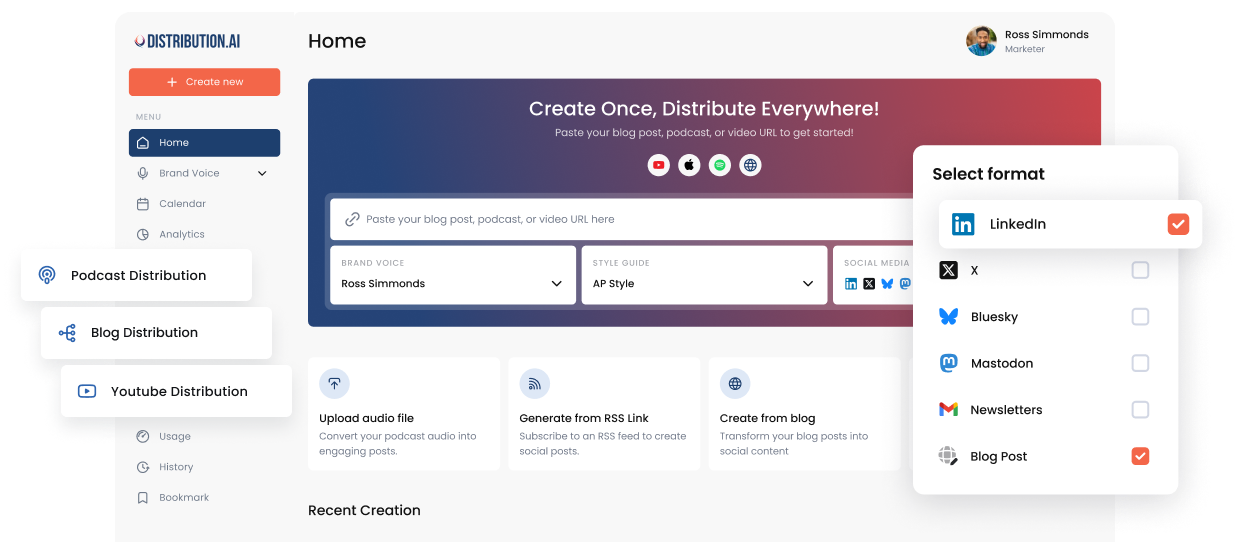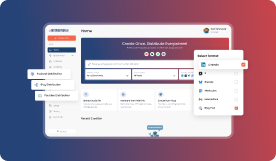The Only Social Selling Guide You Need in 2025 [Backed by Data]
Replace cold calls with warm leads. Our social selling guide reveals how to build authentic online relationships that create a predictable pipeline and drive more revenue.

Social selling refers to the process of using social media platforms to connect with prospects, nurture relationships, and ultimately drive sales.
Unlike the traditional model of cold calls and aggressive pitches, social selling focuses on engaging prospects in a more organic and authentic way.
The key difference?
While traditional methods often rely on volume, social selling emphasizes value. It’s about prioritizing trust and relationships over immediate conversions.
Why Social Selling Is Built for Today’s World
Buyers now do extensive research online before making decisions. They pass through multiple touchpoints before they start considering a purchase.
These touchpoints include targeted, helpful content, such as short videos on social media platforms like TikTok and Instagram, as well as resources like LinkedIn posts and blogs.
This change in buyer behaviour is a problem for attribution models, but an opportunity for social sellers.
|
Even before the awareness stage, a solid multi-format social presence means that customers know you exist, and that’s half the job done. Once they are in the consideration stage, they will naturally gravitate towards your resources.
Helpful resources and a reassuring presence solidify your position as a valuable partner. Think about it this way. You have already provided value to the customer, and now you are upselling a paid product.
This translates to less friction in outreach, booking meetings, explaining value, and closing the sale.
According to LinkedIn’s State of Sales report, 78% of social sellers outperform peers who don’t use social media in their sales strategies.
Why is Social Selling Important?
Social media isn’t just a tool for sharing memes or cat videos anymore; it’s now integrated into the buying process, with 75% of B2B buyers using social media to evaluate products and services.
By adopting a social selling strategy, you’re not just selling a product or service—you’re solving problems, sharing value, and positioning your brand as a trusted authority.
The Benefits of Social Selling
Here’s how social selling provides both immediate and long-term benefits:
- Builds trust through authentic interactions, enhancing brand recall and positioning.
- Simplifies lead generation by connecting with prospects where they already spend time.
- Creates a pipeline that provides a constant supply of leads.
- Lets you rely on warm outreach and eliminates all the problems associated with cold outreach.
- Word of mouth marketing is one of the most powerful growth channels, and social selling provides compounding returns over time by expanding your reach.
- Provides a competitive edge by providing a personalized interaction.
The 4 Pillars of Social Selling

Successful social selling requires more than just hopping onto social media and posting product links. It’s a systematic approach with four central pillars:
Pillar 1: Building a Professional Brand
Your professional brand is the foundation of your social selling strategy. It’s how potential customers perceive you before they even decide to engage. A strong professional brand establishes credibility and positions you as a trustworthy, knowledgeable resource in your industry.
How to Build a Standout Professional Brand
1. Optimize Your Profiles
Ensure your LinkedIn, X (formerly Twitter), or any platform you use for social selling is complete and polished. This includes:
- A clear, professional profile photo. (Pro tip: Use the same image across platforms for consistency.)
- A compelling headline that speaks to your expertise and value proposition.
- A summary that tells your story and highlights your accomplishments.
- Custom URLs to make your profiles easier to find and share.
| Develop a recognizable tone, visual style, and posting schedule that aligns with your personal and company branding. Whether you’re witty, serious, or somewhere in between, make sure your voice resonates with your audience. |
2. Showcase Expertise
Regularly share content that adds value. This can include:
- Industry news and trends with your perspective.
- Case studies that highlight real-world success.
- Tips, tricks, and actionable insights relevant to your audience.
3. Engage Authentically
Respond to comments, participate in discussions, and interact with others’ content to build visibility and rapport. Make sure the content you are posting communicates your point of view and adds value. It absolutely should not be a generic blob of text.
Boilerplate replies go against the entire concept of building an authentic social presence.
Your professional brand should be a living entity, continuously evolving as you grow in your career.
Pillar 2: Finding the Right Prospects
Once you have built a professional brand, it’s time to find the right audience.
Why is building the right audience essential for success?
If you are trying to sell B2B software and your audience consists of people searching for jobs and skincare enthusiasts, they are not going to convert in the end no matter how amazing your presence and product is.
The solution? You need to build a ‘high-intent audience’.
A high-intent audience refers to people who are already in your niche and are highly likely to benefit from your product or look for a similar solution in the near future.
How to Build a High-Intent Audience
- Leverage Advanced Search Tools: Platforms like LinkedIn and Twitter offer robust tools for finding potential leads. Use filters such as job title, industry, company size, and location to narrow your search.
- Monitor Social Signals: Keep an eye on potential customers who engage with your content, participate in relevant discussions, or ask questions related to your niche. These are warm leads that are already showing interest.
- Join Industry-Specific Groups: Community groups on LinkedIn, Facebook, or Slack are goldmines for prospecting. Look for active participants and listen for pain points you can address.
- Use Intent Data: Tools like LinkedIn Sales Navigator or third-party platforms can provide insights into who is actively looking for solutions similar to yours.
- Personalize Outreach: When reaching out to a prospect, reference specific details that show you’ve done your homework—this could be a recent post they made, mutual connections, or shared interests.
Pillar 3: Engaging Prospects with Insights
Once you’ve identified the right audience, the next step is to engage meaningfully. Sharing a link to your product or service isn’t enough; the goal is to provide value that positions you as a thought leader and trusted advisor.
How to Effectively Engage Prospects
- Curate and Share Relevant Content: Stay up-to-date on industry news and trends, and share content that resonates with your audience. Add your commentary to spark deeper conversations.
Example: Instead of simply sharing an article about a new industry regulation, provide your take on how it impacts your audience and what steps they should take.
- Answer Questions Thoughtfully: Prospects often post questions or challenges online. Take the time to provide well-thought-out answers that demonstrate your expertise.
Example: When prospects engage with your posts, don’t just hit ‘like’. Respond with thoughtful comments or follow-up questions to keep the conversation going.
- Publish Original Content: Blog posts, videos, infographics, or even simple text posts can showcase your knowledge.
Example: You can write a LinkedIn article addressing a common pain point in your industry.
You can also create a quick explainer video on a topic your audience struggles with.
66% of customers say that the presence of social proof makes them more likely to make a purchase. Use social proof to reinforce your positioning—share testimonials, success stories, or case studies that highlight how you’ve helped others solve similar problems.
Pillar 4: Building Strong Relationships Online
At its core, social selling is about relationships, not transactions.
To turn prospects into long-term customers, you need to focus on building trust and fostering genuine connections.
Tips for Building Lasting Relationships
- Be Consistent: Regular touchpoints are key to staying top-of-mind. This could be as simple as commenting on their posts, sending a quick “thought you’d find this helpful” message, or sharing relevant resources.
- Personalize Every Interaction: One-size-fits-all messaging doesn’t build relationships. Take the time to tailor your communication to each individual’s needs, preferences, and interests.
- Practice Active Listening: Pay attention to what your prospects are saying online. What are their challenges? What goals are they working toward? Use this information to offer relevant solutions.
- Provide Value Without Asking: Instead of immediately pushing for a sale, focus on helping. Share free resources, offer advice, or connect them with someone who can assist with their challenges.
- Follow Through on Commitments: If you promise to send a resource or follow up on a question, do it. Reliability goes a long way in building trust.
- Nurture Beyond the Sale: The relationship doesn’t end when a prospect becomes a customer. Continue to engage, support, and provide value to turn them into advocates for your brand.
- The Long Game: Relationships take time to develop, but the return on investment is worth it. A well-nurtured relationship can lead to repeat business, referrals, and an extended network of opportunities.
Quick Tactics for Selling on Social MediaWondering how to sell on social media without coming across as pushy? Here are a few essential social selling tactics:
Monitor trends, hashtags, and conversations in your niche to identify when and where to engage.
Share blog posts, whitepapers, or infographics showcasing your expertise.
Initiate meaningful conversations in DMs or comments instead of jumping straight into a sales pitch. Social selling is about offering value upfront, creating an authentic connection, and letting the sale follow organically. |
How to Find Sales Opportunities with Social Selling Tools
Social selling sounds great on paper. But making authentic posts across platforms, engaging with your network, and cultivating relationships take time.
You might be able to so it manually till a point, but social selling tools are necessary for building momentum and kickstarting compounding results.
The right social selling tools can amplify your efforts, making lead generation and engagement much more straightforward.
Must-Try Tools in Social Selling
1. LinkedIn Sales Navigator
Identify and connect with decision-makers in your industry with LinkedIn Sales Navigator.
It moves beyond standard search and provides a powerful suite of features to find and connect with the right decision-makers. Use it to leverage intent data and identify prospects who are actively looking for solutions like yours.
2. Distribution AI
Don’t just schedule posts— create an entire content campaign from a single asset.
Distribution.ai is a true distribution engine that uses specialized AI Agents to turn one blog, podcast, or YouTube video into 10-15+ tailored outputs for every channel.
It automatically maintains your unique brand voice, transforming long-form content into ready-to-publish social posts, show notes, and transcripts without the manual work.
Feel free to sign up for a 15-day free trial.
3. HubSpot CRM
A strong relationship is built on remembering every interaction.
HubSpot acts as your central command center, combining your sales tracking with your social media activity to give you a complete picture of every prospect.
How to Create Platform-Specific Social Selling Strategies

Every social media platform offers unique opportunities to connect with your audience and boost sales through targeted social selling strategies.
But consumer behavior and expectations vary from platform to platform. While some of them are great for initial awareness and bite-sized content, actual deals and in-depth content are best done elsewhere!
The key is to understand the strengths of each platform and tailor your social selling strategy accordingly.
Here’s a quick guide on what works for each platform.
LinkedIn: The Professional Powerhouse
If your focus is on B2B sales, LinkedIn is a goldmine for networking and authority building.
To make the most out of social selling on Linkedin:
- Publish insightful articles that showcase your expertise in your industry.
- Engage in professional groups and forums where your target audience is active. Answer questions, share valuable insights, and establish yourself as a thought leader.
- Leverage LinkedIn’s Sales Navigator to identify and connect with potential leads directly.
LinkedIn’s professional environment makes it an ideal platform to nurture long-term relationships that can lead to high-value sales.
Instagram: A Visual Marketplace
Instagram thrives on compelling visuals, making it perfect for showcasing products and building a brand story.
To excel here:
- Create high-quality posts, reels, and stories to highlight your products’ features and benefits.
- Use carousel posts to tell a story or share tips related to your product category.
- Actively engage with followers through DMs and comments to foster trust and loyalty.
With Instagram’s shopping features, you can also make it easier for users to browse and buy directly from your profile.
X: Real-Time Conversations
X is the go-to platform for real-time engagement, making it a powerful tool for staying relevant in your niche.
Here’s how to leverage it effectively:
- Follow trending topics and hashtags related to your industry and participate in those conversations.
- Host Twitter chats or spaces to engage with your audience in a direct and interactive way.
- Respond to customer inquiries and feedback promptly, demonstrating excellent customer service.
By positioning yourself as an active and knowledgeable participant in your field, you can drive trust and interest in your offerings.
Facebook: Community and Ads
Facebook remains a versatile platform for social selling, thanks to its robust group and ad functionalities.
To maximize its potential:
- Join and contribute to industry-specific groups where your target customers are active. Share valuable content and establish credibility.
- Use Facebook Ads to create highly targeted campaigns that reach the right audience based on location, interests, and behaviors.
- Post regular updates on your business page to keep your audience informed about promotions, events, or new product launches.
Facebook’s wide reach and advanced targeting tools make it a strong contender for businesses of all sizes.
TikTok: The Creative Connector
TikTok’s focus on short, creative videos makes it a powerful platform for reaching younger audiences and showcasing your brand personality. To thrive on TikTok:
- Share behind-the-scenes content that humanizes your brand and builds relatability.
- Create quirky product demonstrations or tutorials that highlight the benefits of your offerings in a fun and engaging way.
- Collaborate with influencers to amplify your reach and credibility.
By leaning into TikTok’s trends and embracing its playful nature, you can capture the attention of an engaged and growing audience.
Take the Leap into Social Selling Today
Social selling is the most powerful strategy for connecting with modern buyers. By building relationships and sharing insights, you can redefine how you drive sales. But the manual work of creating, repurposing, and scheduling content across every platform is a significant drain on your time.
What if you could automate the entire distribution workflow?
Distribution.ai was built to solve this exact problem. Turn a single piece of content into a multi-channel campaign and let our AI agents do the work, so you can focus on building relationships.
Start your 15-day free trial now
*No credit card required. Cancel anytime.
Frequently Asked Questions
1. What’s the difference between social selling and social media marketing?
While they are related, their goals are distinct.
Social media marketing focuses on broadcasting a message to a wide audience to build brand awareness and generate leads at the top of the funnel.
Social selling is a more targeted approach used by sales professionals to build one-on-one relationships with specific prospects, nurture them through personalized engagement, and guide them toward a purchase decision.
2. How long does it take to see results from social selling?
Social selling is a long-term strategy, not an overnight fix.
While you can see initial results like increased engagement and new connections within a few weeks, building the trust required for a consistent sales pipeline takes time.
Most professionals see tangible results in lead quality and conversions after 3-6 months of consistent, dedicated effort. The key is consistency, which is why automating parts of the process is so crucial.
3. Do I need to be on every social media platform to be successful?
Absolutely not. The most effective social selling strategies focus on quality over quantity.
Instead of stretching yourself thin across every platform, identify the two or three channels where your target audience is most active and engaged.
For B2B sales, the primary platform is often LinkedIn. In addition to this, a presence on more informal platforms like Instagram and TikTok also helps. For B2C, the primary platform can be Instagram or Facebook.
Master your chosen platforms and deliver exceptional value there.
4. How much time should I invest in social selling?
Without the right tools, a manual social selling strategy can be a significant time commitment, often requiring an hour or more each day to find content, engage, and post consistently.
However, the goal isn’t just to spend time, but to invest it wisely. By using social selling tools to automate time-consuming tasks like content repurposing and scheduling, you can focus your energy on high-value activities like authentic engagement and building relationships in DMs—the parts that truly drive sales.
5. How can a tool like Distribution.ai specifically help with my social selling strategy?
A successful social selling strategy requires a consistent stream of high-quality, valuable content. Distribution.ai automates the most time-consuming part of this process: content creation and repurposing.
It acts as a distribution engine, using specialized AI Agents to turn a single piece of long-form content— like a blog, podcast, or video—into an entire campaign of ready-to-publish assets.
This ensures you always have on-brand, relevant content to share, freeing you up to focus on engaging with prospects and building relationships.
Frequently Asked Questions
Promote, repurpose & distribute your content with AI
Start 15-Day Free Trial
